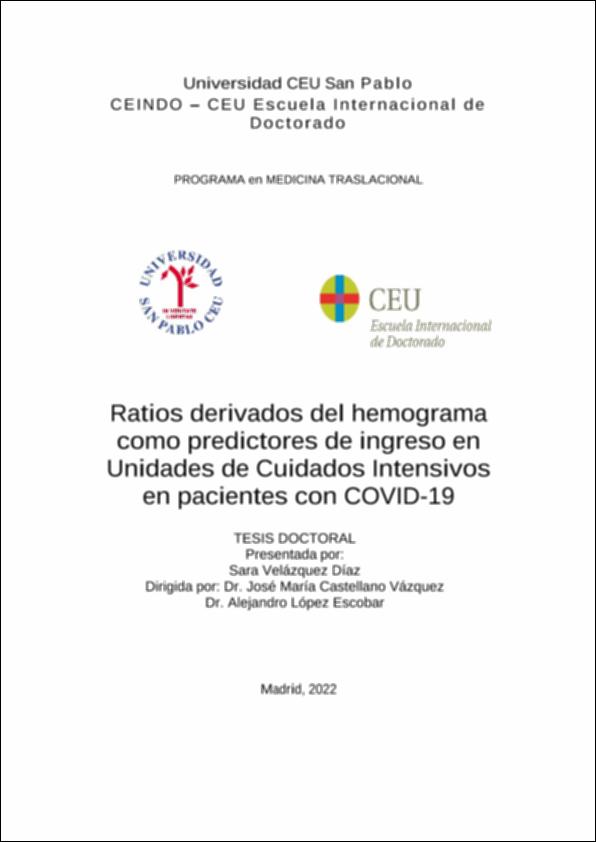Please use this identifier to cite or link to this item:
http://hdl.handle.net/10637/14198Ratios derivados del hemograma como predictores de ingreso en Unidades de Cuidados Intensivos en pacientes con COVID-19
| Title: | Ratios derivados del hemograma como predictores de ingreso en Unidades de Cuidados Intensivos en pacientes con COVID-19 |
| Authors : | Velázquez Díaz, Sara |
| Keywords: | COVID-19; Hemograma; Ratios derivados del hemograma; Ratio neutrófilo-linfocito; Ingreso en UCI; Hemogram; Hemogram-derived ratio; Neutrophil-to-platelet ratio; Neutrophil-to-lymphocyte ratio; ICU admission |
| Abstract: | El gran número de afectados por la infección por SARS-CoV-2 y la potencial gravedad de esta enfermedad hace necesario identificar precozmente aquellos pacientes con alto riesgo de evolución desfavorable.
La COVID-19 es una enfermedad con afectación sistémica. Varios estudios han puesto de relieve que una respuesta inmunitaria anómala es el punto de partida de los fenómenos de hipercoagulabilidad, daño endotelial, macro y microtrombosis, que desencadenarían consecuencias mortales en los pacientes. Las poblaciones de glóbulos blancos (monocitos, linfocitos y neutrófilos), así como las plaquetas desempeñan un papel crucial en el fenómeno de inmunotrombosis descrito en esta enfermedad.
El objetivo del estudio es aclarar si la valoración de cuatro cocientes obtenidos a partir de parámetros habituales de un análisis de sangre (recuentos de estirpes leucocitarias y plaquetas) al ingreso en el hospital, así como la evolución de los mismos, puede ayudar a identificar a los pacientes con formas más severas de la enfermedad que necesitarán cuidados críticos.
Los 4 ratios derivados del hemograma estudiados resultaron ser factores de riesgo de ingreso en UCI. La elevación durante el ingreso del ratio neutrófilo-linfocito, del ratio neutrófilo-plaqueta y del índice de inmunidad-inflamación sistémica aumentó el riesgo de ingreso en UCI.
El ratio neutrófilo-plaqueta es el ratio del hemograma con mayor solidez de predicción del ingreso en UCI. Since first cases of SARS COV-2 were identify in China, the fast spread of the disease and the number of affected and dead people around the world make necessary to identify factors related to bad evolution, so that patients can receive the most adequate assistance. Endothelial injury has been proposed as the main pathophysiological mechanism in the illness development. This lesson releases a large number of immunomodulatory molecules that provoke a hyper inflammation and prothrombotic state. It is known leucocytes and platelets role in inflammation and thrombogenesis. We propose to study if neutrophil-to-lymphocyte ratio (NLR), platelets-to-lymphocyte ratio (PLR), neutrophil-to-platelet ratio (NPR), and the systemic immune-inflammation index (SII) could be useful to identify patients who will have worse evolution and need admission at Intensive Care Units.A retrospective observational study was performed at HM Hospitales including patients with confirmed or suspected infection by SARS-CoV-2 who were admitted to HM Hospitales group in Spain, from March 1 to June 10, 2020. Data from 2453 patients were collected. Patients whose age was under 18 years old (n=5), had missing laboratory data (n=258) or died at hospital admission (n=26) were excluded. Therefore, 2254 (88.6%) patients were included in the final analysis. Patients were divided into two groups, admitted to ICU and not admitted to ICU. Demographic data, comorbidities, epidemiological characteristics, and laboratory findings were collected. Variables with p-value < 0.2 for the difference between patients who were admitted in ICU and patients not admitted in ICU were selected for univariate logistic regression. Bivariate logistic regression models were performed combining one of the inflammatory rates, NLR, PLR, NPR, or SII, with other variables. Patients requiring ICU admission had significantly higher rates at the moment of hospital admission in NLR (6.9 [4 – 11.7] vs 4.1 [2.6 – 7.6], p < 0.0001), PLR (2 [1.4 – 3.3] vs 1.9 [1.3 – 2.9], p = 0.023), NPR (3 [2.1 – 4.2] vs 2.3 [1.6 – 3.2] , p < 0.0001) and SII (13 [6.5 – 25.7] vs 9 [4.9 – 17.5] , p < 0.0001) than those who did not enter ICU. The multivariate logistic regression models performed combining one of the inflammatory rates with other variables demonstrates, NPR remains as a predictor of ICU admission, when adjusted for the more complex model, OR 1.11 (95% CI: 0.98 - 1.22, p = 0.055). The four rates obtained from white blood cells count and platelets count at admission hospital, especially, NPR have shown to be useful as predictor of patients with unfavorable clinical evolution who require ICU admission. |
| Description: | Tesis CEINDO, Universidad San Pablo CEU, Medicina Traslacional, leída el 17 de febrero de 2023 |
| Director(s): | López Escobar, Alejandro Castellano Vázquez, José María |
| Defense date: | 17-02-2023 |
| URI: | http://hdl.handle.net/10637/14198 |
| Rights : | http://creativecommons.org/licenses/by-nc-nd/4.0/deed.es |
| Issue Date: | 17-Feb-2023 |
| Center : | Universidad San Pablo-CEU |
| Appears in Collections: | Medicina Traslacional |
Items in DSpace are protected by copyright, with all rights reserved, unless otherwise indicated.


